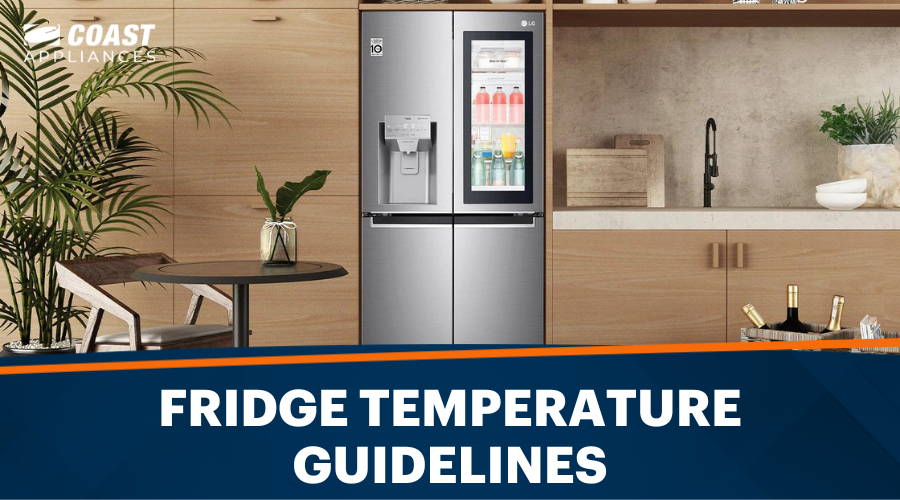Last Updated: February 8, 2025
Most people use their fridges without ever having a second look at the temperature gauge, until something goes wrong. But it's essential to know the correct temperature setting, as there’s a risk of bacteria if your temperature is too high, and a possibility of frozen foods if it’s set too low.
So, what temperature should a refrigerator be at? Unfortunately, there’s a lot of confusion about the ideal refrigerator temperatures, we’re clarifying things here with this article.
In this article, we’ll cover:
- What is the Ideal Refrigerator Temperature?
- Is 37 Degrees Cold Enough for a Refrigerator?
- Is 34 Too Cold for a Refrigerator?
- Is 45 Degrees a Safe Temperature for a Refrigerator?
- At What Temperature Does Food Spoil in the Refrigerator?
- Why is Food Freezing in My Refrigerator?
- What is the Best Temperature for my Freezer?
Find Your Ideal Refrigerator
Check out our full line of top-rated refrigerators.
What is the Ideal Refrigerator Temperature?
Foodsafety.gov reports food safety information provided by government agencies, such as the Food and Drug Administration (FDA), the Centers for Disease Control (CDC), and the Food Safety and Inspection Service (FSIS). The cold food storage requirement under all these agencies is a temperature of 40°F (4.5°C) or less.
While 40°F (4.5°C) protects harmful bacteria from growing, anything too much lower can cause your food to freeze when you don't want it to. So, what should a refrigerator temperature be?
The Department of Agriculture states bacteria multiply quickly in the "Danger Zone," which is temperatures beginning at 40°F (4.5°C). It's best to set your temperature gauge a few degrees below that. Most experts recommend that the ideal temperature setting for a refrigerator is between 35-38°F (1.6-3.3°C). This temp ensures food safety by giving a 2-5 degree buffer in case the temperature gauge isn't wholly accurate.
Trouble Keeping Your Fridge Cool?
If you have temperature problems with your current fridge, we can help. If it turns out it’s time for a new fridge – we have all the major brands and styles you could ever want.
Need more fridge or freezer space to keep your appliance running efficiently? We’re here to help! Whether you're looking for a spacious side-by-side fridge with a pull-out freezer or a classic top-freezer model, we’ll guide you to the perfect fit. Each option offers unique features designed to suit your needs and maximize efficiency. Let us help you find the ideal fridge for your home.
Coast Appliances has the best selection of refrigerators and freezers and offers a price-match guarantee. We also offer exclusive promotions and in-house financing to help offset the cost of your new fridge or any other appliance you’re in the market for.
Find Your Ideal Refrigerator
Check out our full line of top-rated refrigerators.
FAQs About Freezer Temperature
Is 37 Degrees Cold Enough for a Refrigerator?
Yes, 37°F (2.7°C) is an ideal temperature for a basic home refrigerator, since it’s colder than the danger zone minimum stated for bacteria growth. It’s ideal in that it keeps food at an optimal temp in terms of safety, while not being so cold that your food items begin to freeze.
However, if you’re wondering what temperature should a wine refrigerator be set at, 37°F (2.7°C) is definitely too cold!
Is 34 Too Cold for a Refrigerator?
34°F (1.1°C) degrees is probably the lowest setting you'll want to set your fridge temperature at. Any lower can result in frozen food. Remember, 34°F (1.1°C) is a safe setting because bacteria cannot grow at that temp.
Is 45 Degrees a Safe Temperature for a Refrigerator?
As noted, because a temperature of 40°F (4.4°C) or higher can cause bacteria to multiply in your refrigerator, it’s not advised that you set the temp above 40°F (4.4°C). A temperature of 45°F (7.2°C) is not safe, even if your food is only exposed to that temperature for a couple of hours.
At What Temperature Does Food Spoil in the Refrigerator?
Food spoilage begins at 40°F (4.4°C), even if your food is only exposed to that temperature for a short time. Not all food spoils at the same rate – perishable foods like eggs, fish, meat, poultry, and other leftovers typically spoil first. Also, shredded cheeses, dairy items like milk, yogurt, and cream, cooked pasta, and cut fruit are likely to go bad more quickly than some other foods.
Why is Food Freezing in My Refrigerator?
Have you ever opened your refrigerator and found a gallon of frozen milk? Most likely, your temperature is set too low (below 32°F (0°C)), or the temperature gauge is malfunctioning. While those are the most common problems, you could also have a malfunctioning damper, dirty coils, or a bad seal on the door.
What is the Best Temperature for my Freezer?
If you're wondering what temperature should a refrigerator freezer be, the minimum recommended temperature for your freezer is 0°F (-17°C). If your refrigerator doesn’t have a digital gauge, you can use an appliance thermometer right in your freezer to ensure your food is at the proper temperature. Your freezer should be cold enough to preserve food for quite some time.
The best way to ensure that your fridge and freezer are at the correct temperatures is to purchase an appliance thermometer. Some people set one thermometer at the back of the refrigerator and another at the front. Having two thermometers in your fridge or freezer can give you peace of mind that you have the most accurate temperature reading.
It’s a good idea to occasionally check both your fridge and your freezer for optimal temperatures, even if they have a built-in thermostat. Double checking the temperature from time to time is wise, especially if you're having problems with drinks freezing in your fridge, or if food isn’t appropriately freezing in your freezer.












































































































